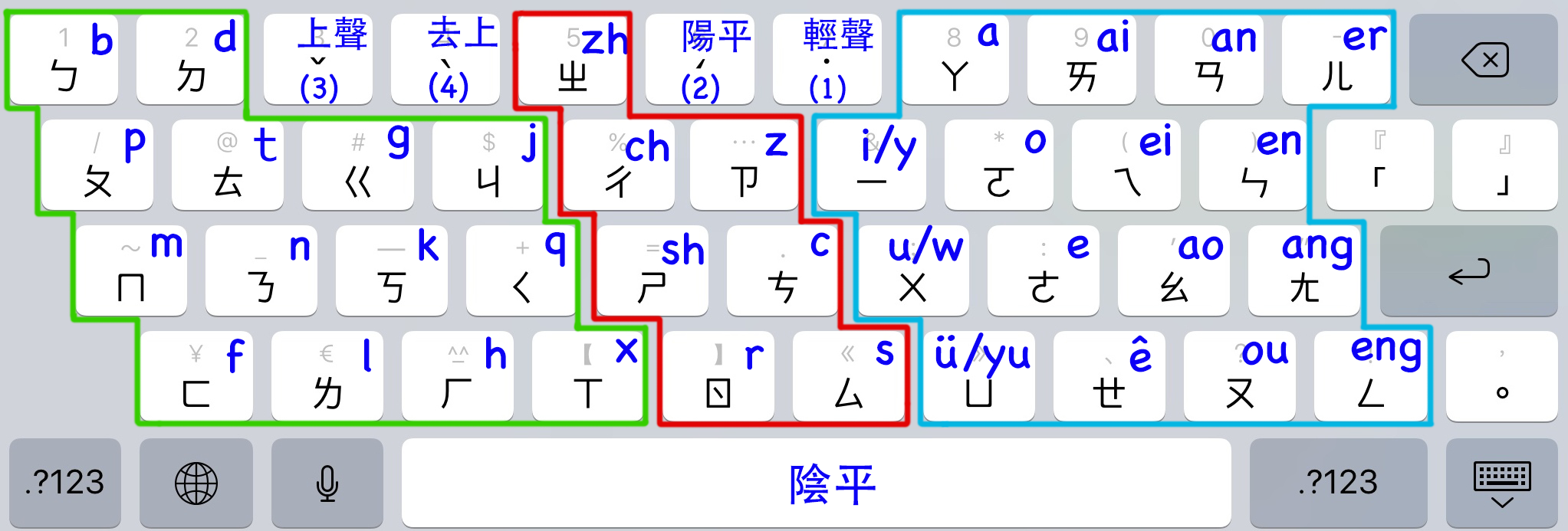Note: this tutorial assumes you’re familiar with pinyin and basic Chinese characters.
Now it’s time to learn 注音! Check out this table we made for you:

As confusing as it might seem at the first sight don’t worry, it’ll take only a couple of days to learn. Use this image as a reference, save it somewhere so it’s accessible within a few seconds – you will need it a lot in upcoming few days (in case of PC you can just set it as a wallpaper).
Some of those symbols are very easy to remember (if you know a decent number of Chinese characters), here’s a quick guide through them:
| Zhuyin | Pinyin | Trick to remember |
| ㄅ | b | Origin: from 勹, the ancient form and current top portion of 包 bāo |
| ㄆ | p | Origin: from 攵 which is a variant of 攴 (pū) |
| ㄇ | m | Can think of character 門 (mén) to remember the “m” sound |
| ㄈ | ||
| ㄉ | d | Origin: from ancient form of 刀 (dāo) |
| ㄊ | t | this one looks a lot like the English letter “t“ |
| ㄋ | n | Origin: from ancient form of 乃 (nǎi) |
| ㄌ | l | from archaic form of 力 (lì) |
| ㄍ | g | |
| ㄎ | k | Origin: from the archaic character 丂 kǎo, but it’s a lot easier to remember this character if you think of 考 (kǎo) |
| ㄏ | h | If you don’t know yet, the radical 厂 is pronounced as (hǎn) and that’s where the zhuyin character is from (you might’ve seen this radical in words like 原 (yuán)) |
| ㄐ | j(i) | Origin: from archaic character 丩(jiū), but it’s a lot easier to remember this character if you think of 叫 (jiào) |
| ㄑ | q(i) | |
| ㄒ | x(i) | Origin: from 下 (xià) |
| ㄓ | zh(i) | Origin: archaic form of 之 (zhī) |
| ㄔ | ch(i) | This one reminds me of 吃 (chī) |
| ㄕ | sh(i) | just think of 屎 (shǐ) |
| ㄖ | r(i) | it was made from an early version of 日 (rì) hence the sound is the same |
| ㄗ | ||
| ㄘ | ||
| ㄙ | s(i) | Think of 私 (sī) |
| ㄚ | a | from 丫 yā (the character means fork and looks like one) |
| ㄛ | o | |
| ㄜ | ê as in 餓 | |
| ㄝ | e as in 也 | Yeah, this one gives the “ye” sound and it derives from the character 也. I wish all zhuyin was this simple. |
| ㄞ | ai | the etymological background is the character 亥 hài |
| ㄟ | ||
| ㄠ | ao | Origin: from 幺 (yāo) |
| ㄡ | ou | Origin: from 又 (yòu) |
| ㄢ | an | Think of 安 (ān) |
| ㄣ | ||
| ㄤ | ang | From 尢 wāng |
| ㄥ | eng | Makes me think of 能(néng) |
| ㄦ | er | I don’t think this one needs an explanation |
| ㄧ | y(i) | Origin: from 一 (yī) |
| ㄨ | w/u | This one reminds me of 我 (wǒ), but its etymology is 㐅, which is ancient form of 五 wǔ (five) |
| ㄩ | yu/ü | Think of 曲 (qū) |
So how does it all work? Three different ways for different characters:
- You take a consonant from the green sector or and combine it with a vowel from the blue sector and then add the tone, example: ㄋㄧˇㄏㄠˇ 你好 (nǐ hǎo)
- Some of the consonants in green and red sectors work standalone ㄕˋ 是 (shì) – you do not need to explicitly add ㄧ (i) to it in zhuyin
- Some vowels also work standalone, ㄞˋ 愛 (ài)
An important rule to remember:
You never finish a word with a character from the blue sector. So, for example, you can’t write “nan” as ㄋㄚㄋ (n_a_n), you can only write it as ㄋㄢ (n_an)
